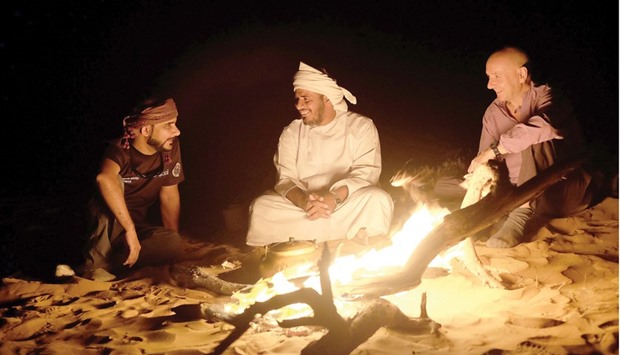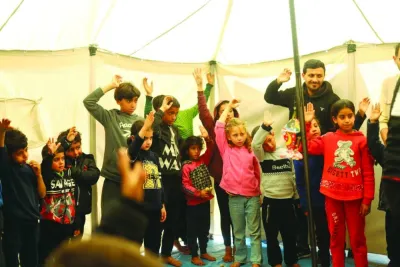More than 1,000 kilometres long and 500 kilometres wide with sand dunes as high as 300 metres interspersed with gravel and gypsum plains. They were up against the barren land that has not been inhabited for decades, and they were on foot.
It took them 49 days of walking, not to say resilience, to get through the arduous journey. Physically sunken from the privations of the all-consuming trip but spirited, the three travellers finally made it to their final destination, Ar Rayyan Castle in Qatar.
It was the thought of this castle that helped them survive the mounds of sand, without going astray. British explorer Mark Evans, and his two Omani colleagues, Mohammed Zadjali and Amer al-Wahaibi, called the Tahaddi Arabia team, walked 1,300 kilometres to cross Rub al Khali or ‘Empty Quarter’.
They were retracing the footsteps of British explorer Bertram Thomas and Sheikh Saleh bin Klute from Oman, who sought to cross the Empty Quarter nearly 85 years ago in 1930. No-one has ever done it on foot in the interim because the ‘Empty Quarter’ is literally empty!
“There is nothing there. It is just barren. For thousands of years no-one has lived there. They did that in the past when the climate was very different and Arabia was green, but for many years it has just been barren, (offering only) hostile environment,” team leader Mark Evans tells Community upon reaching the Rayyan Castle.
They were greeted by HE Sheikh Joaan bin Hamad al-Thani, the president of Qatar Olympic Committee, and ambassadors of Saudi Arabia, Oman and United Kingdom besides other state officials.
‘Tahaddi Arabia’, the journey, started from Salalah, Oman, on the 10th of December 2015, and continued across Saudi Arabia through to the Empty Quarter and culminated in Qatar. It was the same route taken by the explorers in 1930.
Their conclusion? It is “even emptier now!”
“The Bedouin now have pick-up trucks and they have moved to the edge of the desert where environment is relatively easier with employment opportunities,” observes Evans. However, he acknowledges the 1930 explorers were extraordinary, who at the time walked into nothing, with no maps or support system.
Today, life is comparatively easier and it was nice for him and his colleagues to step back and realise “how lucky we are today.”
Evans has lived in the Middle East for 20 years and believes the desert is his home now. For the past 12 years, he has been based in Oman. Nevertheless, he and his team had to thoroughly prepare and train for the epic journey.
They did some stimulatory training in the desert in Oman besides hitting the gym, but it was impossible to physically train for the 7-hour-a-day trek with their full time jobs. So they selected the route carefully.
“We chose the regimen in a way that we had two weeks at the start to enable us to get super fit before we hit the biggest sand dunes on the border with Saudi Arabia. By the time we got there, we were really quite fit, our legs were really strong and we all had lost a lot of weight by then,” Evans recalls.
It was this careful planning, preparation and the right equipment that, he says, was the key to survive out there. Quoting the famous aviator Richard Byrd, he suggested, “there were old pilots, and bold pilots, but no old, bold pilots”.
He probably meant to say, if you are reckless and just dive into something, you are not going to survive.
“That is why we are not old, bold explorers. We are old but we are not bold. We are not reckless. We planned this very carefully. We had two fantastic support vehicles with foods and supply,” says Evans, smiling. He says he chose people on his team, who, he was sure, had the rights skills to do the job. One of his two companions, he says, is a Bedouin who knows how to handle camels which was the most important part of the job. The other, Mohammed Zadjali, is an instructor with Evans’s organisation in Oman.
From his journey in the desert, Evans particularly remembers the nights. The nights in the desert are just fantastic, he says.
“When the sun goes down, it is just beautiful. You know the temperatures are going to drop and the heat is going to die and those amazing stars come out and when there is no moon, that sky is just unbelievable out there,” he recalls.
Their mantra was not to let negative thoughts enter their minds. If it gets difficult, you look for solutions and they had enough resources with them to solve any problems, says the team leader. This journey has not been recreated for 85 years and will probably not be for another 85 years and this, Evans says, makes them feel honoured and privileged.
His colleague Mohammed Zadjali, himself an experienced explorer, concurs.
“The survival is in team effort. I would always convince myself that Doha was right in front of me and we would move on. It is all about resilience, tenacity and patience besides problem-solving skills,” says the Omani explorer.
He said the route offered every hardship imaginable. They went up the mountain to the South which is 2,000 metres, dropped down to the sandy bit where the sand dunes go up to 300 metres; however, the real test was the sharp rocky terrain. Imagine walking 30 kilometres on such a terrain day after day.
“Your blistered feet get swollen to the extent that it is difficult sometimes even to remove your shoes,” says Zadjali.
He has been an explorer for over 12 years but this, he says, was his biggest expedition. And he, Zadjali says, wanted to give the message that despite having political borders, “we are all brothers and we will always be.”
With his next expedition — destination yet to be decided — he wants to drive home the importance of protecting the environment. His team leader and colleague has undertaken many expeditions before to the Arctic, Greenland, besides paddling a one-man boat around the entire 1700km coastline of Oman and Qatar.
However, he too feels ‘Empty Quarter’ was right up there. But what’s up next for him?
“For now, a good night’s sleep. I had my first shower in 49 days this afternoon. I am going to have another one tonight. I am going to have a big meal and then a good night’s sleep,” he smiles, rubbing his over-grown stubble.

TEST OF ENDURANCE: The explorers say teamwork and co-ordination was at the heart of their successful feat.


